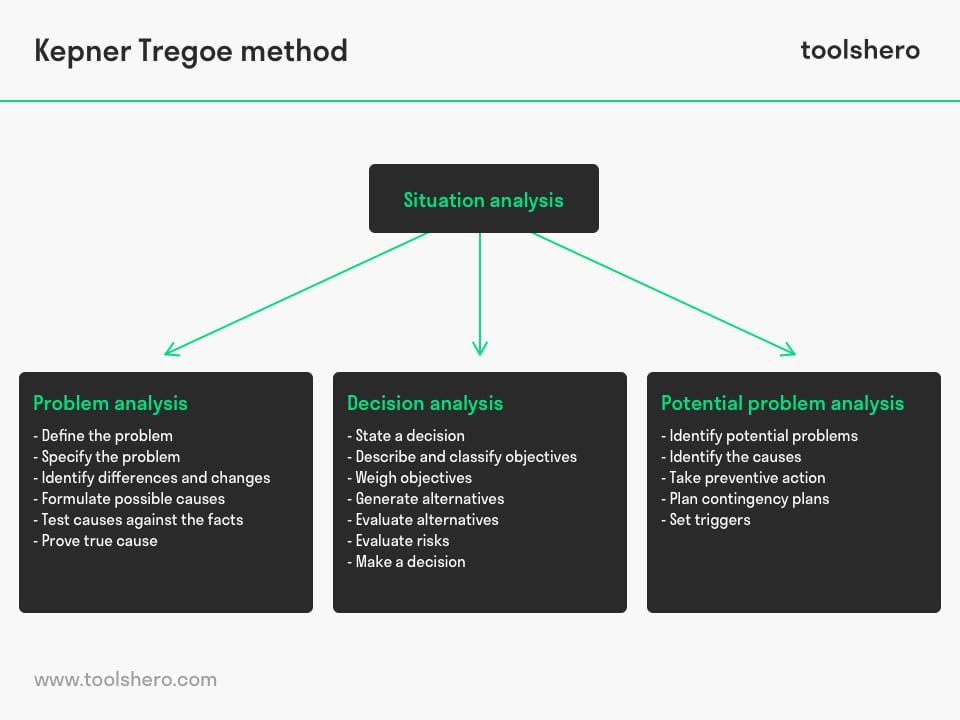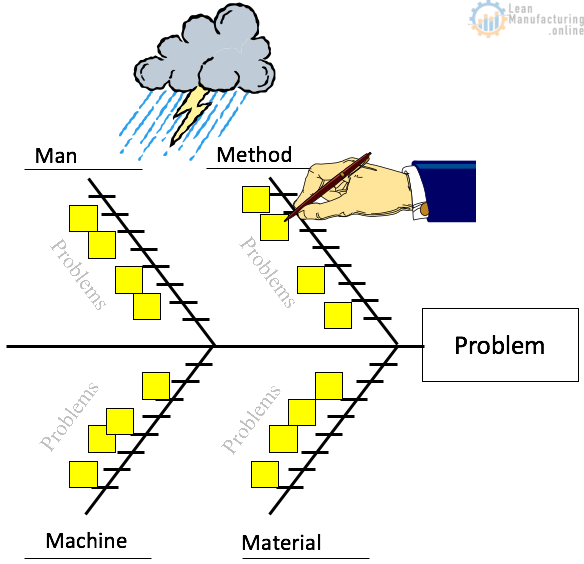- Memberships

Kepner Tregoe Method of Problem Solving

Kepner Tregoe Method of Problem Solving: this article explains the Kepner Tregoe Method , also known as the KT-method , developed by Charles Kepner and Benjamin Tregoe in a practical way. Next to what this is, this article also highlights rational processes, the importance of cause and that this method is effective. After reading, you’ll have a basic understanding of this problem solving process. Enjoy reading!
What is the Kepner Tregoe Method?
Problems occur in any given organization. Often there is pressure of time to solve the problems and it is debatable what the right way of solving these problems is.
The Kepner Tregoe method or KT-method is a problem analysis model in which the “problem” is disconnected from the “decision” . An English synonym for this problem solving method is Problem Solving and Decision Making (PSDM).

Traditional thinking pattern
The founders Charles Kepner and Benjamin Tregoe developed a rational working method in the 1960s in which they researched and identified the troubleshooting skills of people.
Throughout the centuries mankind has learned to deal with complexity and to (directly) anticipate on this. As a consequence, the traditional thinking pattern became a part of human nature.
When solving problems people search for the answer to the following four questions:
- What happened?
- Why did it happen?
- How should we act?
- What will be the (future) result?
Kepner Tregoe method: rational processes
To break through this traditional pattern Charles Kepner and Benjamin Tregoe came up with four rational processes in which four fundamental questions are reflected:
1. Situation analysis
This clarifies the problem situation (what happened).
1.1 Problem analysis
Here the actual cause of the problem and the relationship between cause and result are searched for (why did it happen).
1.2 Decision analysis
Based on the decision making criteria, choices are made to arrive at potential problem resolutions (how should we act).
1.3 Potential Problem analysis

Figure 1 – Kepner Tregoe Method Analysis
Distinction
According to the KT-method, different tasks involve different problems, which in turn need different approaches. A situation analysis will clarify the distinctions in all these processes and as a result it will be possible to search for suitable solutions. This situation analysis provides an insight into necessity, priority and urgency of the various tasks.
When it has become clear which tasks are to be prioritized (action list) preparations can be made for potential problems. By using a good problem analysis in advance, a process will be created to prevent future problems or in emergencies, to limit the damage.
The strengths of this method does not stop there. Apart from the fact that problems are specified in terms such as “what, where, when and how big”, the Kepner Tregoe Method focuses on anything that cannot be the cause of the problem.
Certain causes are therefore excluded. Based on a “this is” and “this is not” analysis a clear overview of possible causes can be created and this makes the troubleshooting process consistent.
The Kepner Tregoe Method is efficient
The KT-method deploys an efficient troubleshooting process. Through research Charles Kepner and Benjamin Tregoe discovered that the registration of a problem is not a uniform process. In spite of the available information, people usually process information badly, misinterpret this or overlook important matters.
In addition, Charles Kepner and Benjamin Tregoe examined the discrepancies between successful and less successful troubleshooting.
They discovered that a predetermined logical method facilitates the search for the causes of a problem. In their “Best practice in troubleshooting” , they describe this methodology, which forms the basis for this method.
The Kepner Tregoe Method is Effective
This method is universal and is still used today in many organizations to track down problems and identify potential causes. Apart from the fact that the Kepner Tregoe Method leads to an explanation of problems, it also helps improve mutual understanding within an organization.

It’s Your Turn
What do you think? Is the Kepner Tregoe Method applicable in today’s modern organizations? Do you recognize the practical explanation or do you have more suggestions? What are your success factors for the good Kepner Tregoe Method set up?
Share your experience and knowledge in the comments box below.
More information
- Lussier, R. N. (2005). Management fundamentals: concepts. applications, skill development . Cengage Learning .
- Payne, S. L. & Marty, C.S. (1966). The Rational Manager: A Systematic Approach to Problem Solving and Decision Making . Journal of Marketing. Vol. 30 Issue 1, p97.
- Kepner, C. H. & Tregoe, B. B. (1965). The Rational Manager . McGraw-Hill.
How to cite this article: Mulder, P. (2012). Kepner Tregoe Method . Retrieved [insert date] from Toolshero: https://www.toolshero.com/problem-solving/kepner-tregoe-method/
Original publication date: 06/30/2012 | Last update: 12/09/2023
Add a link to this page on your website: <a href=”https://www.toolshero.com/problem-solving/kepner-tregoe-method/”>Toolshero: Kepner Tregoe Method</a>
Did you find this article interesting?
Your rating is more than welcome or share this article via Social media!
Average rating 3.7 / 5. Vote count: 30
No votes so far! Be the first to rate this post.
We are sorry that this post was not useful for you!
Let us improve this post!
Tell us how we can improve this post?

Patty Mulder
Patty Mulder is an Dutch expert on Management Skills, Personal Effectiveness and Business Communication. She is also a Content writer, Business Coach and Company Trainer and lives in the Netherlands (Europe). Note: all her articles are written in Dutch and we translated her articles to English!
Related ARTICLES

Pareto Analysis explained plus example

Root Cause Analysis (RCA)

Soft Systems Methodology (SSM) by Peter Checkland

Convergent Thinking: the Definition and Theory

CATWOE Analysis: theory and example

Means End Analysis: the basics and example
Also interesting.

8D Report and template

Fishbone Diagram by Kaoru Ishikawa explained

Crowdsourcing: the meaning, definition and some examples
4 responses to “kepner tregoe method of problem solving”.
I am stunned to read that the Kepner Tregoe Method “…… IS STILL used today in many organizations to track down problems and identify potential causes…..”. I have used it all the time along my career as a manager of organizations, with extreme success. As a tool for identifying problems, as a tool for taking better decisions. So, please, I would appreciate to know what kind of system is being used now instead of an approach like K-T, to have provoked your comment about the existence of an alternative way of thinking.
Other than KT, I also use the Analytic Hierarchy Process (AHP) Like KT, it forces discipline and analysis and it helps to explain why decisions are made with understandable background and data. Many of the old Total Quality Management tools are also useful for solving problems and making good management decisions. Nominal Group Technique, Pareto Charts, and weighted multivoting are all quite useful. ITIL is the new way of thinking, but it can be rather dry and robotic unless it is underpinned with good decision tools.
Thank you for your comment and sharing your experience Pete.
Seems that I naturally deal with problems this way without knowing a name for it. In fact, it seems obvious to me that this approach should be taken anyway.
Leave a Reply Cancel reply
You must be logged in to post a comment.
BOOST YOUR SKILLS
Toolshero supports people worldwide ( 10+ million visitors from 100+ countries ) to empower themselves through an easily accessible and high-quality learning platform for personal and professional development.
By making access to scientific knowledge simple and affordable, self-development becomes attainable for everyone, including you! Join our learning platform and boost your skills with Toolshero.

POPULAR TOPICS
- Change Management
- Marketing Theories
- Problem Solving Theories
- Psychology Theories
ABOUT TOOLSHERO
- Free Toolshero e-book
- Memberships & Pricing



Victor Leung

Understanding the Kepner-Tregoe Technique - A Guide to Enhanced Problem-Solving and Decision-Making

In the dynamic world of business, the ability to efficiently solve problems and make decisions is crucial for success. The Kepner-Tregoe technique, developed by Charles H. Kepner and Benjamin B. Tregoe, is a structured methodology that aids in the systematic analysis and resolution of problems. This blog post delves into the essence of the Kepner-Tregoe technique, exploring its key components and benefits.

What is the Kepner-Tregoe Technique?
The Kepner-Tregoe technique is a problem-solving and decision-making framework that provides a systematic approach for identifying, analyzing, and resolving issues. It consists of four main processes:
Problem Analysis : This process involves defining the problem, understanding its nature, and diagnosing the root cause. By distinguishing between what is known and unknown, the problem is clarified, making it easier to identify potential solutions.
Decision Analysis : This step is crucial for making informed decisions. It involves evaluating alternatives against a set of objectives and identifying the risks associated with each option. This helps in selecting the most feasible and beneficial solution.
Potential Problem (or Opportunity) Analysis : Here, the focus shifts to forecasting future issues or opportunities. This proactive approach helps in preparing for potential challenges and capitalizing on opportunities that may arise from the decision made.
Situation Appraisal : This involves assessing the situation to prioritize issues, plan the next steps, and allocate resources effectively. It helps in managing multiple problems or decisions simultaneously.
Benefits of the Kepner-Tregoe Technique
Enhanced Problem-Solving Skills : The technique fosters a deep understanding of the problem, leading to more effective solutions.
Improved Decision-Making : By systematically evaluating alternatives, the technique ensures that decisions are well-informed and aligned with objectives.
Risk Management : It helps in identifying potential risks and prepares organizations to mitigate them effectively.
Efficient Resource Allocation : By prioritizing issues, the technique ensures that resources are used optimally.
Fosters Team Collaboration : The structured approach encourages teamwork and clear communication, making it easier to reach a consensus.
Implementing the Kepner-Tregoe Technique
To effectively implement the Kepner-Tregoe technique, organizations should:
Train Employees : Provide training to develop the necessary skills for applying the technique.
Encourage a Systematic Approach : Foster a culture where problems are approached methodically, using the Kepner-Tregoe processes.
Utilize in Various Scenarios : Apply the technique across different types of problems and decisions to maximize its benefits.
Regularly Review and Refine : Continuously assess the effectiveness of the technique and make adjustments as needed.
The Kepner-Tregoe technique is a powerful tool for organizations seeking to enhance their problem-solving and decision-making capabilities. By providing a structured approach, it not only leads to better outcomes but also promotes a culture of strategic thinking and collaboration. Implementing this technique can be a game-changer for businesses aiming to navigate complexities with greater confidence and efficiency.
Ready for more?
Knowledge for Professional and Personal Development
Mastering Kepner-Tregoe Methodology for Decision Excellence

The Kepner-Tregoe matrix is a problem-solving technique that helps businesses make better decisions. It focuses on gathering, organizing and evaluating key decision-making information.
Through their research, Charles Kepner and Benjamin Tregoe found that breakdowns in problem solving often stem from people misprocessing information or jumping to conclusions. They developed a predetermined logical method that helps teams find and fix the cause of a problem.
Introduction to Kepner-Tregoe Decision Analysis
Exploring the kepner-tregoe problem analysis model, steps in kepner-tregoe decision making process, applying kepner-tregoe techniques in business, benefits of kepner-tregoe method in problem solving.
If you want to become a more confident decision maker, you need to learn the right approach to problem solving. Using the Kepner Tregoe method (also known as the KT-method) will help you to develop a structured and systematic process for approaching problems. This approach will not only help you avoid bad decisions, but it will also allow you to identify and understand the root causes of a problem. This is critical to finding the most effective solution.
The KT-method was developed by Charles Kepner and Benjamin Tregoe in the 1960s and is often referred to as the “Kepner-Tregoe Matrix,” the “Kepner-Tregoe Decision Analysis” and the “Problem Solving and Decision Making Method” (PSDM). This approach was designed to counteract hasty and emotion-driven decision-making by providing a structure for analyzing options.
This method is widely used in the business world for two common but critical types of decisions: capital expenditures and hiring. These large financial commitments are usually complex and require a variety of stakeholders to participate in the decision- making process. Incorporating KT Decision Analysis can ensure that all stakeholder concerns are addressed and a clear and effective plan for action is developed.
Many businesses use the KT-method in product development to help them make data-driven choices. For example, Apple’s engineering team used the KT-method when designing the iPhone X. This enabled them to systematically address engineering challenges such as integrating Face ID into a borderless display. The result was an innovative new feature that also helped to improve customer experience and quality.
Using the KT-method can also help you build a culture of problem solving and error management. At the DURAG GROUP in Hamburg, Germany, employees have embraced this methodology by training and coaching their peers to do so. This has led to a positive change in corporate culture, including the implementation of a clear thinking framework and support structure. This was recognized in 2022 when the DURAG Group won the Kepner-Tregoe Excellence Award for Organizational Culture of Critical Thinking.
Developing a systematic framework to solve problems and make decisions is crucial for any business. The Kepner-Tregoe Problem Analysis model is a powerful tool that helps individuals and teams systematically analyze a problem, determine its causes, and develop effective solutions. This method was developed by Charles Kepner and Benjamin Tregoe in the 1950s, and it is used worldwide in businesses and organizations to improve problem-solving skills.
The Problem Analysis model involves a four-step process that starts with clearly defining the problem. This step is often skipped by immature troubleshooters, who rely on hunches and instincts to diagnose issues. However, jumping to conclusions may lead to an expanded problem or a permanent solution that simply masks the symptoms of the original issue. By taking the time to fully understand what has happened, teams can avoid wasting time and resources by avoiding unnecessary actions.
When determining the causes of a problem, it’s important to isolate the elements that have an impact on the event, while ignoring those that do not. This process is called CATWOE (causal, alternative, technical, logical, environmental). The use of this method allows teams to identify the cause of the problem and find a lasting solution.
KT training teaches the tools and techniques to help you think clearly, resolve problems confidently, and make informed decisions. This one-day workshop is ideal for leaders and employees who are responsible for making decisions or analyzing problems in operations, quality, manufacturing, IT, customer service, research and development, maintenance, and more. Learn to avoid decision-making biases and practice your new skills in a classroom setting, then apply them back on the job. KT delivers clarity and confidence to help you achieve the results you need, every day.
The Kepner-Tregoe decision making model is a structured process that helps people make better decisions. It involves setting clear objectives, assessing and prioritizing alternatives, and creating ways to control potential negative effects. The framework is sometimes referred to as the KT matrix, the KT method or Problem Solving and Decision Making (PSDM). Developed by Charles Kepner and Benjamin Tregoe, it’s an unbiased process that’s designed to limit unconscious biases.
The KT process includes a step called “Situation Appraisal.” This involves evaluating the current state of the problem and identifying possible threats and opportunities. This step is critical to ensuring that the solution addresses the right issues and is effective.
Another critical KT methodology component is the Problem Analysis step, which is used to identify and prioritize possible causes of the problem. This step is important because it helps to ensure that the final solution will resolve the problem and prevent it from occurring again.
KT techniques can be applied to a wide range of business decision-making processes, including project management, customer service, quality assurance, and operations. It’s a useful tool for solving complex problems and improving communication across teams.
Whether you’re an individual making business decisions or leading a team, learning KT methodologies can help you think more clearly and make confident choices. Our KT Decision Analysis course teaches you the key principles of this scalable, systematic decision-making method and provides hands-on practice with an actual case study. The training is ideal for professionals in engineering, quality, manufacturing, IT, customer service, and more.
A structured decision making process is an excellent tool to have in your business arsenal for solving complex problems. It helps you avoid emotional reactions and other biases to come up with more reliable and effective solutions. The Kepner Tregoe method can be applied to a variety of decisions, including personnel decisions, product development, operational improvements and anything else that requires critical thinking skills.
The basic tenets of the Kepner Tregoe model are situation appraisal, problem analysis, decision analysis and potential problem analysis (Hill, 2012). It helps businesses systematically analyze a problem and identify its root causes. The model also teaches managers to evaluate each option and its risks before making a final decision.
Several companies use the Kepner Tregoe technique to improve their operations. For example, Microsoft Customer Service (CSS) implemented the method to reduce incident resolution times and improve customer satisfaction. In just three months, they were able to reduce DTS by an average of 1 day per case and total TMPI by 27 minutes per case. This was a major accomplishment for CSS.
Additionally, Toyota uses the Kepner Tregoe approach to improve production efficiencies and quality. They used the Five Whys technique alongside the Kepner Tregoe methodology to create a lean manufacturing system. This enabled them to produce cars in half the time as their competitors and improve customer satisfaction.
Amazon customer service teams also utilize the Kepner Tregoe technique to resolve customer issues. They follow a structured problem-solving process based on the matrix to determine the cause of an issue and recommend solutions. This ensures that customers get the help they need in a timely manner. Moreover, the company uses this framework to develop an organizational culture of critical questioning and comprehensive decision making.
The Kepner-Tregoe method provides a structured approach to analyzing problems and making decisions. It can help individuals and teams avoid jumping to conclusions or making assumptions based on past experience, which can lead to costly mistakes. This systematic approach to analyzing a problem also reduces the amount of time needed to resolve issues and deliver results.
The process focuses on finding the actual cause of an event instead of searching for the most convenient solution. It also emphasizes identifying potential risks and establishing a plan of action to minimize the negative effects. This method is often marketed as unbiased and limits conscious or unconscious biases. However, it’s important to remember that someone still has to assign relative values for Want objectives and options satisfaction as well as the probability of occurrence of adverse reactions.
Using the Kepner-Tregoe approach can be a great way to improve IT incident management processes and accelerate root cause analysis. Microsoft, for example, used the method to develop its Customer Support Services (CSS) organization and training, resulting in reduced case resolution times and improved customer satisfaction metrics.
Kepner-Tregoe is an excellent tool for analyzing quality and customer service issues. It identifies the “who, what, when, where, and how” of an incident or problem, making it easy for team members to find and identify the causes of an issue. It can also help to distinguish what is and what is not the problem, which is a critical step when solving complex problems. It is also easier to apply than other methodologies like Six Sigma, which requires a deeper understanding of statistical data and analysis. However, both methods have their pros and cons depending on the situation.
Save my name, email, and website in this browser for the next time I comment.


Benjamin B. Tregoe OBITUARY
Benjamin B. Tregoe Jr., co-founder and chairman emeritus of Kepner-Tregoe, Inc., died on April 20 of complications from non-Hodgkins lymphoma. He was 77. In 1958, Dr. Tregoe and Dr. Charles H. Kepner left the RAND Corporation, where they worked as systems researchers, to found Kepner-Tregoe and Associates, Inc. Innovative pioneers, the two social scientists conducted original research with major corporations and discovered a core set of analytical problem-solving and decision-making processes that continue to be recognized as universally valid. Today, 400 of the 1,000 largest corporations worldwide use Kepner-Tregoe management methods. Their company, which later became Kepner-Tregoe, Inc., is headquartered in Princeton, NJ and conducts business in over 50 countries and 20 languages. Since its inception, Kepner-Tregoe has transferred its problem-solving, decision-making, and planning approaches to millions of managers. Dr. Tregoe and his colleague, John W. Zimmerman, also developed a process for strategic decision making that has helped many top management teams set and implement strategy. Dr. Tregoe provided the inspiration and leadership for Kepner-Tregoe over many years. He held a firm belief in the quality and depth of development for every associate as they delivered Kepner-Tregoe’s services to clients. He was conceptionally brilliant, a tough questioner, and a sensitive counselor. Dr. Tregoe and his company have been a significant force in organization development, pioneering both the train-the-trainer approach and process consulting, both of which have become common practice. He was elected to the Human Resource Development Hall of Fame. Dr. Tregoe was a leading lecturer and published extensively in journals throughout the world. His first book, The Rational Manager, which was co-authored with Dr. Kepner in 1965, is recognized as a landmark publication in the field of management methodology. He also co-authored The New Rational Manager: An Updated Edition for a New World (1997); Top Management Strategy: What It Is and How to Make It Work (1980); Vision in Action: Putting a Winning Strategy to Work (1989); The Culture of Success: Building a Sustained Competitive Advantage by Living Your Corporate Beliefs (1997); and Analytic Processes for School Leaders (2001). In 1993, Dr. Tregoe realized a long-held dream when he established the Tregoe Education Forum. This nonprofit organization provides students in middle and high schools with the critical-thinking skills needed to effectively solve problems, make decisions, and work together. Dr. Tregoe was born in San Francisco on December 23, 1927. He graduated from Redondo Union High School in Redondo Beach, CA in 1945. After serving in the U.S. Marine Corps, he received his bachelor’s degree from Whittier College and a Ph.D. in sociology from Harvard University. He also received an honorary LL.D. from Whittier College, where he served as a trustee and a board member. He was a member of the board of directors of The J.M. Smucker Company, the National Alliance of Business, The World Affairs Council of Philadelphia, and the Princeton Day School. He served as chairman of an advisory committee to the dean of the Graduate School of Arts and Sciences at Harvard University. He is a past member of the Young Presidents’ Organization, where he served as international education chairman and a member of the board, and a member of the Chief Executives’ Organization. Dr. Tregoe is survived by his wife, Jeannette Tregoe; two daughters, Cynthia Richetti and Elizabeth Gonzalez; one son, Benjamin B. Tregoe III; and two grandchildren, Kaleigh and Gavin Richetti. Arrangements are under the direction of the Mather-Hodge Funeral Home, Princeton, NJ 609-924-0242. A memorial service will be held at the Nassau Presbyterian Church in Princeton, NJ at 11 a.m. on Monday, April 25. Following the service, a luncheon reception will be held at the Nassau Club, 6 Mercer Street, Princeton. In lieu of flowers, contributions may be made to the Benjamin Bainbridge Tregoe Fellowship Fund, The Graduate School of Arts and Sciences, Harvard University, University Hall 3 North, Cambridge, MA 02138-3654 or to the Cancer Support Group and Programs of Care of the Nassau Presbyterian Church, 61 Nassau Street, Princeton, NJ 08540.
Honor with Flowers
In memory of Benjamin
Plant a Living Memorial
Using the Kepner-Tregoe Methodology for Effective Problem-Solving
The Kepner-Tregoe methodology is a problem-solving and decision-making framework that helps individuals and organizations systematically analyze problems, make decisions, and manage risks. Developed by Charles Kepner and Benjamin Tregoe in the 1950s, the methodology has been widely adopted by businesses, governments, and other organizations worldwide. One of the core components of the Kepner-Tregoe methodology is the use of a matrix to identify the root cause of a problem. In this article, we will explore how the matrix works and how it can be used to solve complex problems.
The Kepner-Tregoe methodology consists of four distinct steps: Situation Appraisal, Problem Analysis, Decision Analysis, and Potential Problem Analysis. Each step is designed to help individuals and teams approach complex problems in a structured and systematic way. In this article, we will focus on the Problem Analysis step, which involves identifying the root cause of a problem using a matrix.
The Problem Analysis step begins with defining the problem. This step involves clearly stating the problem and its impact on the organization. Next, the team identifies the symptoms of the problem. Symptoms are the visible or measurable indicators of the problem. Once the symptoms are identified, the team uses a matrix to identify the root cause of the problem.
The matrix used in the Kepner-Tregoe methodology is called the Cause and Effect Analysis matrix, also known as the Ishikawa or fishbone diagram. The matrix is a visual tool that helps individuals and teams identify the underlying causes of a problem. The matrix is structured like a fishbone, with the problem or effect at the head of the fishbone and the potential causes of the problem branching off like a fish’s bones.
To use the matrix, the team first identifies the problem or effect that needs to be analyzed. This is written at the head of the fishbone. Next, the team identifies the major categories of potential causes that may be contributing to the problem. These categories are written on the main branches of the fishbone. Examples of potential categories include people, processes, technology, and the environment.
Once the major categories are identified, the team begins to brainstorm the potential causes within each category. Each potential cause is written on a small branch of the fishbone. The team continues to brainstorm potential causes until all potential causes have been identified.
Once the potential causes have been identified, the team begins to analyze each cause to determine its likelihood of contributing to the problem. This analysis involves evaluating each potential cause based on its ability to explain the symptoms of the problem. The team also considers the likelihood that each potential cause is contributing to the problem and the potential impact of each cause on the organization.
Based on this analysis, the team can identify the root cause of the problem. The root cause is the underlying issue causing the problem’s symptoms. Once the root cause has been identified, the team can develop and implement a solution to address the problem.
In conclusion, the Kepner-Tregoe methodology is a powerful tool for problem-solving and decision-making. The Problem Analysis step, which uses the Cause and Effect Analysis matrix, is a critical methodology component. By using the matrix, teams can systematically identify the root cause of a problem and develop effective solutions. Whether you are an individual or a team member, the Kepner-Tregoe methodology can help you approach complex problems confidently and clearly.
References: Kepner, C. H., & Tregoe, B. B. (2013). The new rational manager. Princeton, NJ: Princeton Research Press. Wu, T. (2019). An overview of the Kepner-Tregoe problem-solving methodology. Journal of Applied Management and Entrepreneurship
- More By sensei
- More In Blog

Enhance Efficiency with These Key Maintenance Scheduling Strategies

Mastering Maintenance Planning: Steps to Boost Efficiency

Mastering Quality Department KPIs: A Comprehensive Guide

Maximize Efficiency with the Right Plant Layout: A Comprehensive Guide

Harnessing Business Excellence in Manufacturing Through the PDCA Approach

The Fishbone Diagram

How to Ace Your Next Job Interview: Expert Insights and Strategies

Mastering the Trio: Project, Program & Portfolio Management

Behaviors that kill employee motivation
Leave a reply cancel reply.
Your email address will not be published. Required fields are marked *
Most Popular

4M Analysis Process
The purpose of this procedure is to define the steps to do a 4M …

PDCA – A Process Approach

OPL – One Point Lesson Template – Free Download

5S Audit Checklist and Report

Why-Why Analysis
Blog Search

- Terms of Use
- Privacy Policy
- About Our Ads
Simulation-based training solutions
Learning best-practice problem solving techniques using state-of-the-art simulation technology, engineers have gaming systems at home – let´s give them one at work to make learning fun.
Our simulation-based programs that feature robots and gamification, bring the fun into learning with interactive and responsive troubleshooting exercises.
Learning through simulation helps individuals develop a deeper understanding of complex concepts and provides the opportunity to experience consequences of their actions in a safe to fail environment.
We know there is no substitute for hands-on experience with troubleshooting. That is why our simulation has realistic elements such as time pressure and “information overload” embedded into the experience, creating a sense of urgency and risk – just like problem solving in day-to-day work environments.
It also creates a highly engaging and collaborative team-building experience. Working through exercises together, celebrating successes, and overcoming setbacks, strengthens bonds and helps develop a team spirit between group members. Virtually all our participants state that their team-collaboration skills, and confidence in their peers, has been improved!
At KT, we are committed to continuously improving the learner experience and the return-on-investment for our clients. We have invested in innovative simulation learning experiences to help learners become active participants in the learning journey, leading to more immediate and deeper skill development, which leads to faster and more impactful business results.
Benefits of Simulation-based learning
| ✓ | Learning through reflection on doing increases retention rates of new concepts and builds confidence |
| ✓ | Solving problems in a realistic environment bridges the gap between theory and practice, and shortens the time to results |
| ✓ | Simulation-based scenarios create an engaging, dynamic and interactive experience that maximizes the motivation to learn |
| ✓ | Practicing in a safe-to-fail learning environment allows people to learn from mistakes and more easily transfer the skills onto their jobs |
Simulation Offerings
All new: PSDM xp →
Frontline for Operations →
Frontline for ITSM & Tech Support →
Troubleshooting Simulation →
Risk Mitigation for Operations →
Risk Mitigation for IT →
Troubleshooting Simulation Team Championship →
Subscribe to the KT Newsletter

COMMENTS
Often there is pressure of time to solve the problems and it is debatable what the right way of solving these problems is. The Kepner Tregoe method or KT-method is a problem analysis model in which the "problem" is disconnected from the "decision". An English synonym for this problem solving method is Problem Solving and Decision Making ...
The Kepner-Tregoe Matrix comprises four basic steps: Situation Appraisal - identify concerns and outline the priorities. Problem Analysis - describe the exact problem or issue by identifying and evaluating the causes. Decision Analysis - identify and evaluate alternatives by performing a risk analysis for each and then make a final decision.
Skills developed during a Kepner-Tregoe Problem Solving & Decision Making (PSDM) workshop enable you to: Conduct root cause analysis (RCA) on complex problems. Make tough decisions aligned with operational priorities. Identify and plan for the resolution of high-priority issues. Understand and proactively manage risks and opportunities.
Benjamin Tregoe and Charles Kepner were originally researching the way our minds work - how we solve problems and make decisions. They were interested in the factors that make someone a good problem solver, for example. They formulated an approach that attempts to emulate the thought patterns of someone with excellent problem solving skills.
90 minutes of self-paced eLearning. High-level, rapid overview of various well-known problem-solving methods and tools, including KT Problem Analysis. An infographic on the problem solving ecosystem and a document containing the pros and cons of each method and tool. A discount for a future KT training workshop. Certificate of completion.
Kepner and Tregoe's method offers a structured approach to problem-solving. By taking things step by step, it ensures you're thorough and systematic in your approach.
Highlights from Kepner-Tregoe and Cisco presentation at TSW Conference 2011. Part I of a presentation from Dave Broenen of Cisco Systems on how Cisco turned the tables to get profitable results from their support organization. In this video Dave challenges the natural affinity of service organizations to favor software and technical training as ...
The Kepner-Tregoe technique is a problem-solving and decision-making framework that provides a systematic approach for identifying, analyzing, and resolving issues. It consists of four main processes: Problem Analysis: This process involves defining the problem, understanding its nature, and diagnosing the root cause.
Learn about the benefits of Kepner-Tregoe Problem Solving and Decision Making for your organization. Find root cause, make better decisions, manage risk and ...
In this video, there is an overview of the Kepner-Tregoe systematic problem-solving method which explores finding the cause of a problem by identifying when the problem does and when the problem ...
In this era of digital transformation, an agile mindset is required to quickly assess complex situations, solve problems, and make good decisions. The KT Problem Solving Learning Path provides a foundational understanding of Kepner-Tregoe's Situation Appraisal and Problem Analysis methodologies combining the power of dynamic application-based ...
This sequel to Can You Analyze This Problem? (May-June 1965) describes the Kepner-Tregoe concepts and procedures for problem analysis. The main steps of a systematic approach to problem analysis include defining the problem, outlining the specifications, spotting the distinction, seeking the cause, and, if necessary, respecifying the problem. The use of a specification worksheet allows ...
The Kepner-Tregoe decision making model is a structured process that helps people make better decisions. It involves setting clear objectives, assessing and prioritizing alternatives, and creating ways to control potential negative effects. The framework is sometimes referred to as the KT matrix, the KT method or Problem Solving and Decision ...
1. An explanation of the Kepner-Tregoe approach to problem solving and decision making. Most of the informa tion was taken from an analysis of the book, The Rational Manager. 2. A comparison of the Kepner-Tregoe approach to other systems and ideas of problem solving and decision making.
First developed in the 1960s by Charles Kepner and Benjamin Tregoe, the Kepner-Tregoe process is a systematic approach to problem-solving used in a variety of industries, including business and government. The process involves four key steps: situation appraisal, problem analysis, decision analysis, and. potential problem analysis.
The Kepner-Tregoe approach replaces hit-or-miss methods with a systematic method of problem solving and decision making. Managers who train in this concept of problem analysis often discover that their reasoning methods in handling problems and decisions are faulty. Readers test their own reasoning powers against the problems presented in a case history, based on an actual situation, and can ...
Within the first year following KT training and the introduction of problem-management tools, client-facing incidents (Priority 1, Severity 1) were reduced by 50%, and an additional 20% reduction was realized during the second year. 39%. increase in productivity. Read full case study.
KT's Potential Problem Analysis (PPA) tool has been used for over 60 years to mitigate risk. While your company may use robust risk management tools, PPA is practical thinking to avoid unexpected problems and the damage they can cause. Use it anytime, when managing projects, launching new products and making decisions.
This method is a very powerful tool for problem solving.It is a structured methodology for gathering information and prioritizing andevaluating it.It is very...
Benjamin B. Tregoe Jr., co-founder and chairman emeritus of Kepner-Tregoe, Inc., died on April 20 of complications from non-Hodgkins lymphoma. He was 77. In 1958, Dr. Tregoe and Dr. Charles H. Kepn…
Skills developed during a Kepner-Tregoe Problem Solving & Decision Making (PSDM) workshop enable you to: Conduct root cause analysis (RCA) on complex problems. Make tough decisions aligned with operational priorities. Identify and plan for the resolution of high-priority issues. Understand and proactively manage risks and opportunities.
The Kepner-Tregoe methodology is a problem-solving and decision-making framework that helps individuals and organizations systematically analyze problems, make decisions, and manage risks. Developed by Charles Kepner and Benjamin Tregoe in the 1950s, the methodology has been widely adopted by businesses, governments, and other organizations ...
Kepner-Tregoe Problem Solving methods and training have been helping companies and individuals improve their Problem Solving skills and processes since 1953 with a proven track record of success. We understand that every organization is different and through our experience we can help you identify and implement the right Problem Solving tools ...
Kepner-Tregoe Thailand, LLC 230 CS Tower, 9th Floor Rajchadaphisaek Road Huaykwang, Bangkok 10320 Thailand Malaysia +603-7660-9128